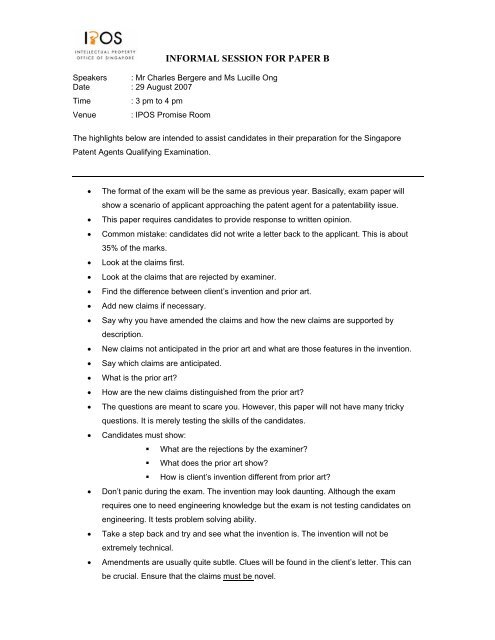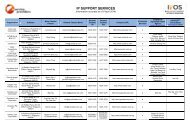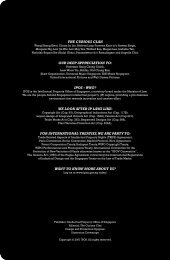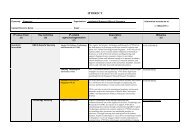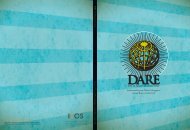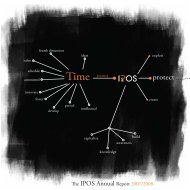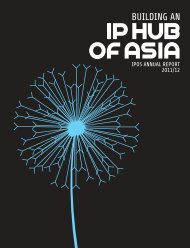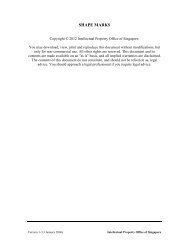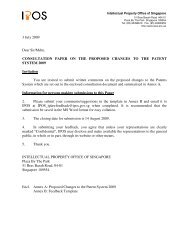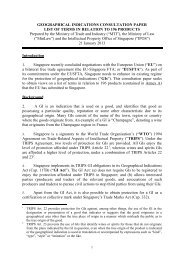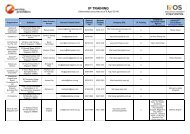INFORMAL SESSION FOR PAPER B
INFORMAL SESSION FOR PAPER B
INFORMAL SESSION FOR PAPER B
You also want an ePaper? Increase the reach of your titles
YUMPU automatically turns print PDFs into web optimized ePapers that Google loves.
<strong>IN<strong>FOR</strong>MAL</strong> <strong>SESSION</strong> <strong>FOR</strong> <strong>PAPER</strong> BSpeakers : Mr Charles Bergere and Ms Lucille OngDate : 29 August 2007Time : 3 pm to 4 pmVenue : IPOS Promise RoomThe highlights below are intended to assist candidates in their preparation for the SingaporePatent Agents Qualifying Examination.• The format of the exam will be the same as previous year. Basically, exam paper willshow a scenario of applicant approaching the patent agent for a patentability issue.• This paper requires candidates to provide response to written opinion.• Common mistake: candidates did not write a letter back to the applicant. This is about35% of the marks.• Look at the claims first.• Look at the claims that are rejected by examiner.• Find the difference between client’s invention and prior art.• Add new claims if necessary.• Say why you have amended the claims and how the new claims are supported bydescription.• New claims not anticipated in the prior art and what are those features in the invention.• Say which claims are anticipated.• What is the prior art?• How are the new claims distinguished from the prior art?• The questions are meant to scare you. However, this paper will not have many trickyquestions. It is merely testing the skills of the candidates.• Candidates must show:• What are the rejections by the examiner?• What does the prior art show?• How is client’s invention different from prior art?• Don’t panic during the exam. The invention may look daunting. Although the examrequires one to need engineering knowledge but the exam is not testing candidates onengineering. It tests problem solving ability.• Take a step back and try and see what the invention is. The invention will not beextremely technical.• Amendments are usually quite subtle. Clues will be found in the client’s letter. This canbe crucial. Ensure that the claims must be novel.
<strong>IN<strong>FOR</strong>MAL</strong> <strong>SESSION</strong> <strong>FOR</strong> <strong>PAPER</strong> B• Thoroughly understand the client’s invention. Know how it is different from prior art.• Check the dates of the prior art. If the prior art is not relevant, do not waste time arguingagainst them. Know what allowable amendment under section 84 is. If not supported bythe description, then, it is not allowed.• Do past year papers. It really helps. The examiner’ comments are also important. Tellpeople the issues that should be addressed.• Compare your answers against the answer guidelines. Good practice for candidates.• When answering the questions, give alternatives on what could happen. Tell the client upfront. Recommend options in the letter and explain reasons supported by the description.This is in the event that the new claims cannot overcome the prior art.• In the letter to the client, put down your own thoughts on how candidates arrive at theirdeductions. Do not just put one correct answer, put down alternatives as well. Proposeone that has the broadest coverage.• Candidates will be given an extra set of the question paper. They can just mark up theadditions in the claims.• If candidates ran out of time, use bullets (no choice). But the examiners prefer a properpresentation. Clients don’t like to see draft. Many candidates ran out of time for the letterto the client. They spend a lot of time on amending the claims, and wrote only a fewsentences for clients’ letter. It makes them lose a lot of marks.• Do not just compare the claims of the prior art. Look at the whole prior art. Look at thedisclosure of the prior art. Do not analyze their claims.• It is not required to cite case laws. Do not make legal arguments. Give client properadvice. Know the PCT filing requirements as well.


